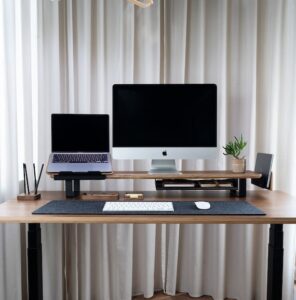In the quest for creating the perfect office environment, one question often surfaces: “Which direction is best for the office desk?” This article delves into the nuances of desk orientation, exploring how direction can impact productivity, comfort, and overall well-being in a workspace.
Summary Points:
- Importance of desk direction in office setups
- Influences of different directions on work efficiency
- Feng Shui principles in desk orientation
- A scientific perspective on optimal desk placement
- Personalization and ergonomic considerations
Desk Orientation: North, South, East, or West – What’s Best for Productivity?
Deciding on the optimal direction for your office desk involves considering various factors, including cultural beliefs, environmental impact, and personal preference. Here’s a breakdown of what each direction might offer:
Facing North
- Cultural Aspect: There’s no specific cultural or scientific consensus favoring the north direction for desk placement. However, it’s crucial to consider individual comfort and workspace layout when choosing this direction.
Facing South
- Potential Drawback: Some experts suggest avoiding a south-facing desk as it might make focusing and getting work done more challenging.
Facing East
- Performance Boost: Orienting your desk to face east is recommended to improve performance and increase output. This direction benefits from early sunlight, reducing the need for artificial light and potentially boosting mood and energy levels.
- Vastu Shastra: This direction aligns with principles from Vastu Shastra, a traditional Indian system of architecture, which suggests that facing east can enhance thinking and productivity.
Facing West
- Not Recommended: Similar to the south, facing west is generally advised against due to potential difficulties in maintaining focus and productivity.
Northeast and Southwest Alternatives
- Combining Benefits: If facing directly north, east, south, or west isn’t feasible or comfortable, consider the northeast or southwest directions. The northeast direction is suggested to reduce depression and improve focus, while the southwest isn’t widely discussed but could be a compromise if other directions are not suitable.
Experimentation is Key
- Finding What Works for You: Despite these guidelines, the most important factor is what works best for you. Experiment with different orientations to find the position that maximizes your comfort, focus, and productivity.
In conclusion, while cultural practices like Vastu Shastra and Feng Shui offer guidelines on desk orientation, personal preference and the specific conditions of your workspace play a significant role. Whether facing east for early sunlight, avoiding south and west for better focus, or experimenting with northeast and southwest, the best direction for your office desk is ultimately one that suits your individual needs and enhances your work experience.
The Significance of Desk Orientation

The direction in which your desk faces in an office can significantly affect your work experience. It’s not just about the view or the amount of sunlight; it’s about how the direction influences your focus, energy, and productivity. Let’s unpack this concept further.
- Psychological Impacts: Desk orientation can influence mood and motivation.
- Environmental Factors: Light exposure and ease of access can be affected.
- Cultural Beliefs: Feng Shui and Vastu Shastra offer unique insights.
“The direction of your desk is not just a matter of space but a matter of perspective.” – Office Design Guru
In the realm of office design, Feng Shui plays a pivotal role. This ancient Chinese art form suggests that facing your desk towards the north can promote career growth, while the east can boost creativity. However, these are not hard and fast rules; cultural beliefs vary, and personal preference plays a crucial role.
The Science Behind Desk Placement
While cultural beliefs offer one perspective, science provides another. Research indicates that the direction of your desk can influence factors like light exposure and ergonomics, which are crucial for a healthy work environment.
- Light Exposure: Desk-facing windows can offer natural light, boosting mood and energy levels.
- Distraction Reduction: Facing away from high-traffic areas can minimize distractions.
- Ergonomic Positioning: Desk orientation should facilitate a comfortable posture and ease of movement.
Desk orientation is not just about facing a certain direction; it’s about integrating ergonomic principles to ensure a comfortable and productive workspace.
Personal Preferences and Ergonomics
While external factors are important, personal preference and comfort should not be overlooked. The ideal desk direction varies from person to person, depending on individual needs and workspace constraints.
- Personal Comfort: Choose a direction that feels most natural and comfortable.
- Workspace Constraints: Room size and layout can dictate feasible orientations.
- Individual Needs: Consider personal productivity patterns and work habits.
Remember, the best direction for your office desk is one that aligns with your personal needs and the specific constraints of your workspace.
Conclusion
In conclusion, the best direction for your office desk depends on a blend of cultural beliefs, scientific research, and personal preferences. Whether you follow Feng Shui, adhere to ergonomic principles, or prioritize personal comfort, the key is to create a workspace that fosters productivity, comfort, and well-being.
For more insights on creating the perfect office setup, explore similar articles:





